5 Textiles Of India - Get To Know The Gorgeous Fabrics, Craftsmanship, And Techniques
5 minuteRead

From trading to fashion, Indian textiles and fabrics have always been instrumental in fetching a lot of attention from around the globe. India is celebrated as a land of grandiose culture, glorious heritage, and illustrious textiles and fabrics. All the regions of our country from north to south and east to west are brimming with their textile industries and the artisans are painting the canvas of fabrics with their art of designing and weaving. Every nook and corner of our country is augmented with some or the other legacies that are being carried to date. And we can proudly say that the textiles and fabric industries are one major part falling under this umbrella.
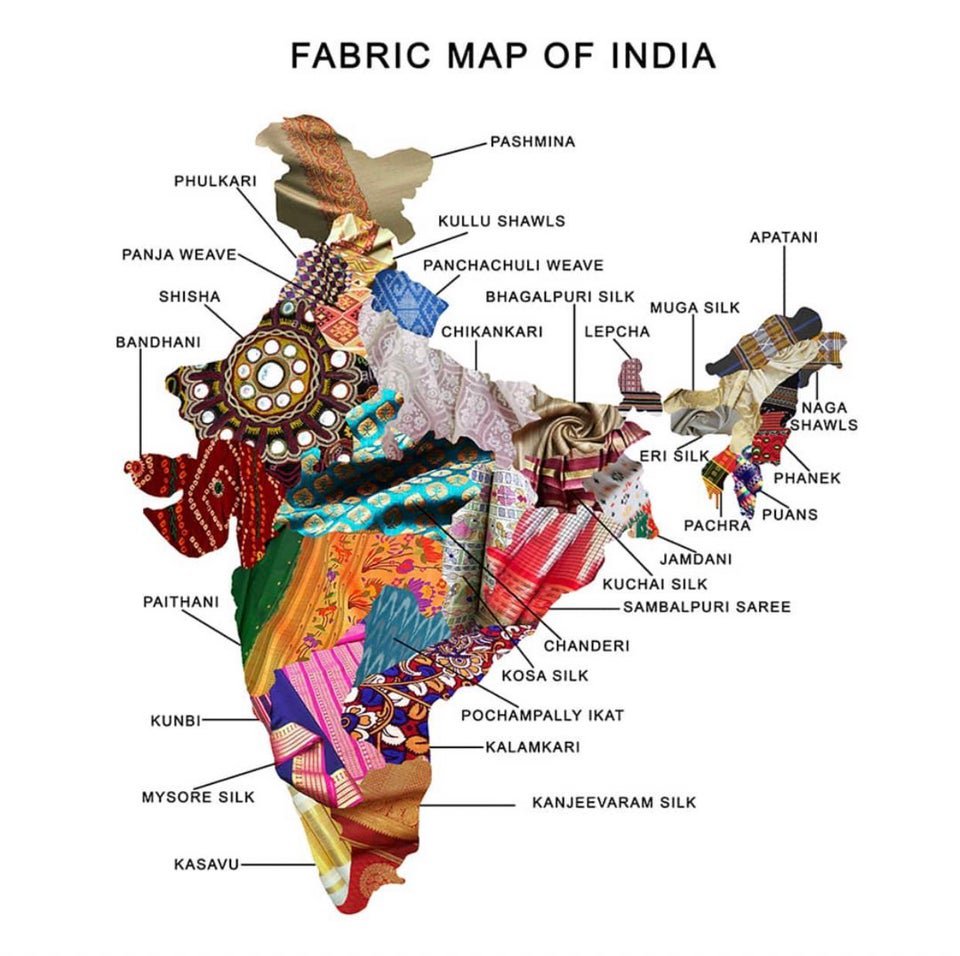
Source- https://www.reddit.com/r/MapPorn/comments/iwu59i/the_fabric_map_of_india/
No matter whether you are a fashion enthusiast or not, your heart will skip a beat when you will bless your senses with the sight and touch of the fabrics made in India. You might have always wondered what are those sarees in your mom’s closet are for ‘special occasions', right? Well, those are the ones made with fabrics where the true Indian values, cultures, and traditions are weaved in. All of those gorgeous sarees have a story weaved in them and are made with utmost passion and vehemence by the craftsman of our country.
The textiles and fabric industry is so vast that not only is it one of the largest textile sectors in the world but is also a medium for a humongous amount of citizens to fetch bread and butter for their families. That being said, let’s dive into the ocean of the various fabrics and textiles found in India and learn about the prolific techniques and craftsmanship of a few of them!
Chikankari Embroidery from Lucknow, Uttar Pradesh

Source- https://adahbespoke.com/product/chikankari-pure-georgette-suit-kurta-dupatta-7/
Known for its glorious Nawabi culture, Lucknow city in Uttar Pradesh has given birth to this extremely intricate form of embroidery using a ‘reshmi’ or silk thread. It is said that this form of embroidery was unfolded by Nur Jahan and since then this type of embroidery came into existence and came to be known as the ‘Chikankari’ work. The motifs and the patterns of this embroidery are rooted in the beautiful creepers, flowers, and leaves present in nature. It is a process of replicating the delicacies of nature on a piece of soft cloth using the techniques of stitching. Wearing anything having a Chikankari work on it will make anyone look no less than a royal Nawab.
The technique followed for creating a Chikankari patchwork is extremely intricate and is done with silk or cotton threads and the patterns and motifs are woven on lighter or pastel-coloured fabrics like muslin, georgette, cotton, or silk. To match the steps with fashion, Chikankari work has also seen several changes in the patterns, colours, and fabrics used.
Banarasi Silk and Brocades- Varanasi, Uttar Pradesh
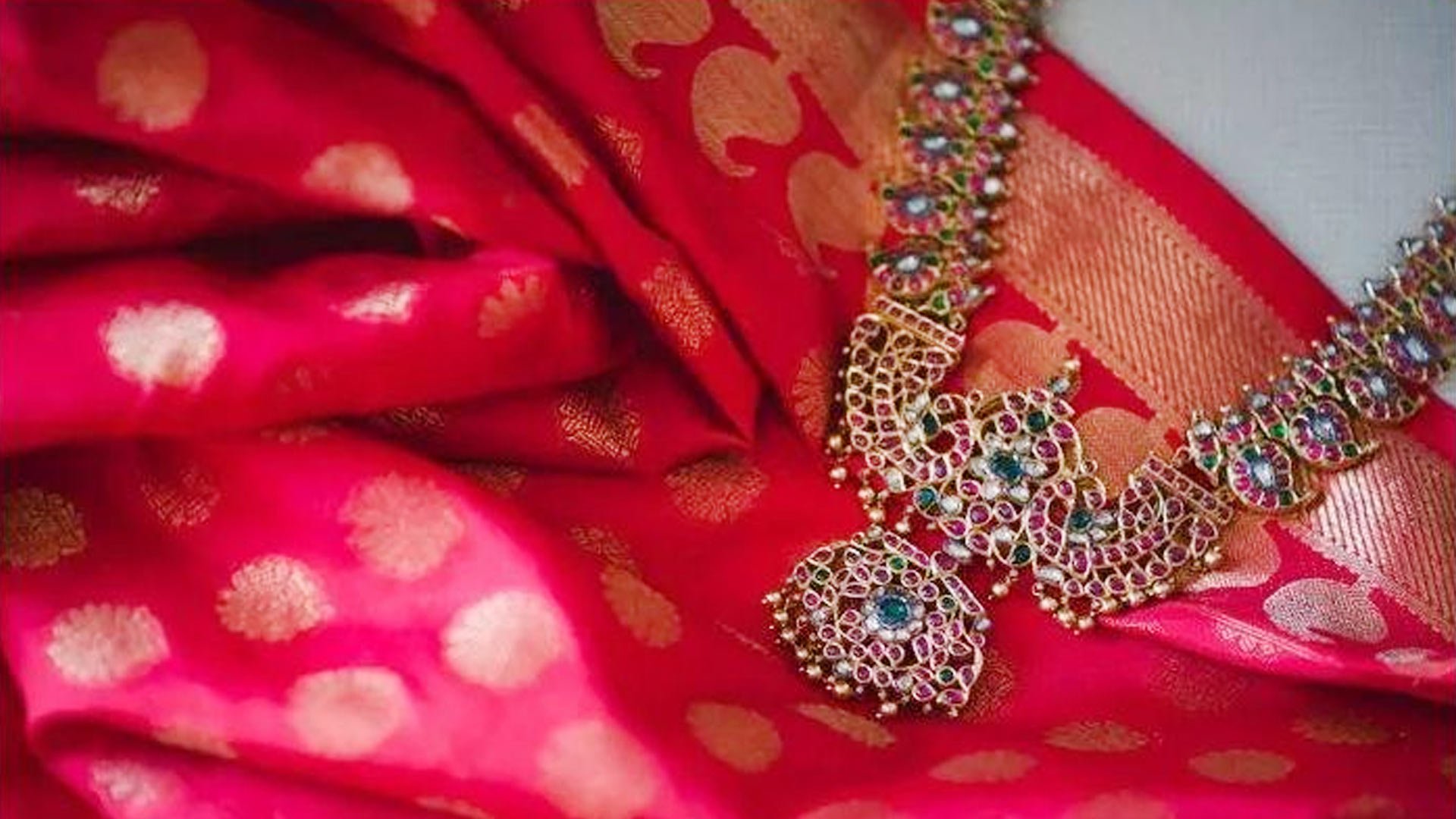
Source- https://peachmode.com/blog/the-tale-of-the-banarasi-saree/
A city gracing the banks of the River Ganges has nurtured the art of weaving fine silk clothes with beautiful intricate zari or brocades in rich silver and golden colors. Banarasi silk sarees are famous across the globe for the delicate yet royal look that they exude. The inspiration for these zari designs is taken from the beautiful floral, Mughal, and leafy motifs, and they are woven into the fabric using two rich colours. The craftsmen of this city have honed the skills of the ‘minakari’ work on the fabrics that give the royal and queenly look to the Banarasi silk. The ghats of River Ganga and the brocades of Banarasi silk are the two gems of this city.
The famous Jangla technique of the Banarasi silk work is done by attaching the threads to the top of the loom and attaching their corresponding ends to the warp. This work demands intricate and complex weaving of the motifs on the silk fabrics. This is also one of the oldest techniques followed by the craftsmen of the city.
Baluchari and Swarnachari silk- Murshidabad, West Bengal
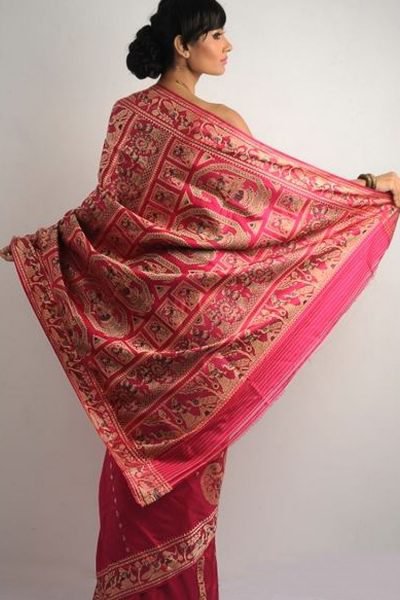
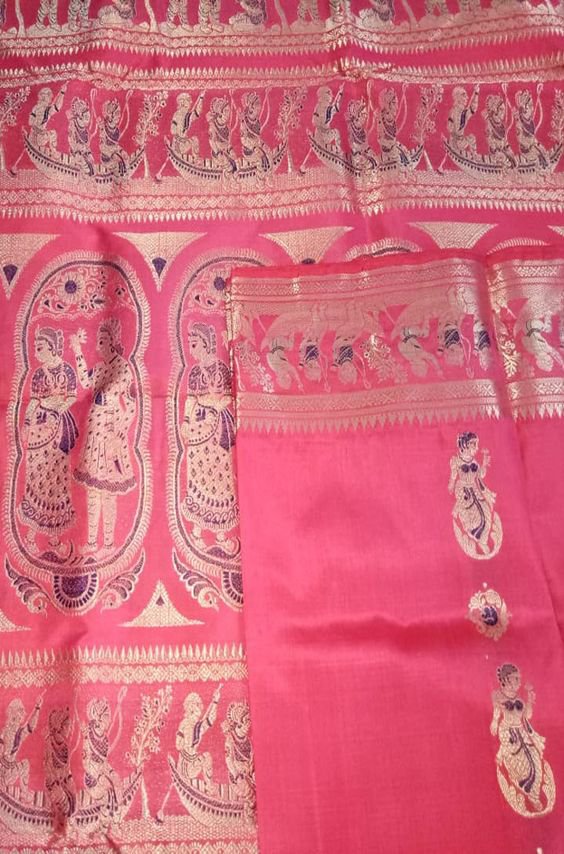
Source- https://in.pinterest.com/pin/529384131197032346/
Flamboyant silk sarees with the whole story of the mythological figures being displayed on the pallus are known as the gorgeous Baluchari and Swarnachari silk sarees from West Bengal. These sarees commemorate the scenes and depictions of the Nawab and her wife. The pallus of the Baluchari sarees are woven with the thread yarn and on the other hand, the pallus of the Swarnachari sarees are done with the gold zari work. These sarees again portray the richness and luxuriousness of Indian textiles.
The Baluchari sarees have long pallus dedicated to the embroidery work with the thread yarns depicting the mythological scenes. The colours of the threads used depend upon the colour of the pallus. The making of the Swarnachari sarees involves the blending in of the rich gold zari forming patterns and figures of the mythological scenes. The minakari work on the pallus of both these sarees makes it a gracious piece of cloth to ornate Indian beauties.
Bandhani from Gujarat
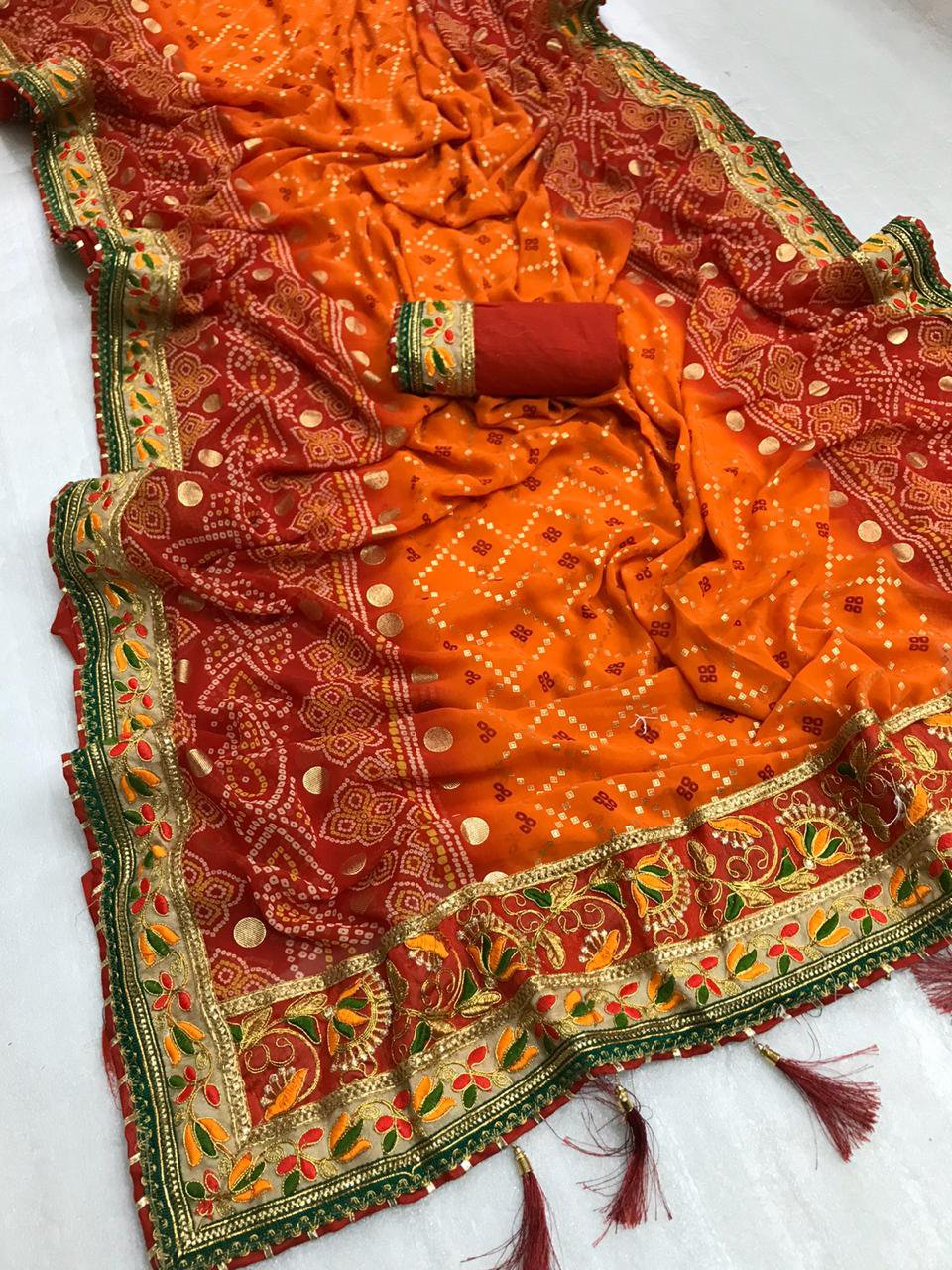
Bandhani or Tie and Dye is a type of textile or fabric that is an illustration of the rich hues, patterns, and mirror work on the clothes. The origination of this beautiful textile that is all colours and shines is from the rich states of Gujarat and Rajasthan. The Khatri community in Gujarat first started the manufacturing of this fabric. Bandhani is a word procured from the word ‘bandhan’, which initially means ‘to tie’. This is how the art and technique of creating this fabric started in the state and the addition of scintillating hues and mirrors has aggrandized the entire look and feel of the textile.
There are several methods and techniques for tie and dye such as ombre, sunburst, folding, etc. Depending upon the types of patterns needed, the techniques of the process of dying the cloths changes accordingly. Being an ancient art, started around 5000 years back, tie and dye is a very famous and celebrated textile of India across the seas as well as in the country. It can elevate the look of anyone wearing a dress made of it with utter elegance.
Paithani Silk from Aurangabad, Maharashtra
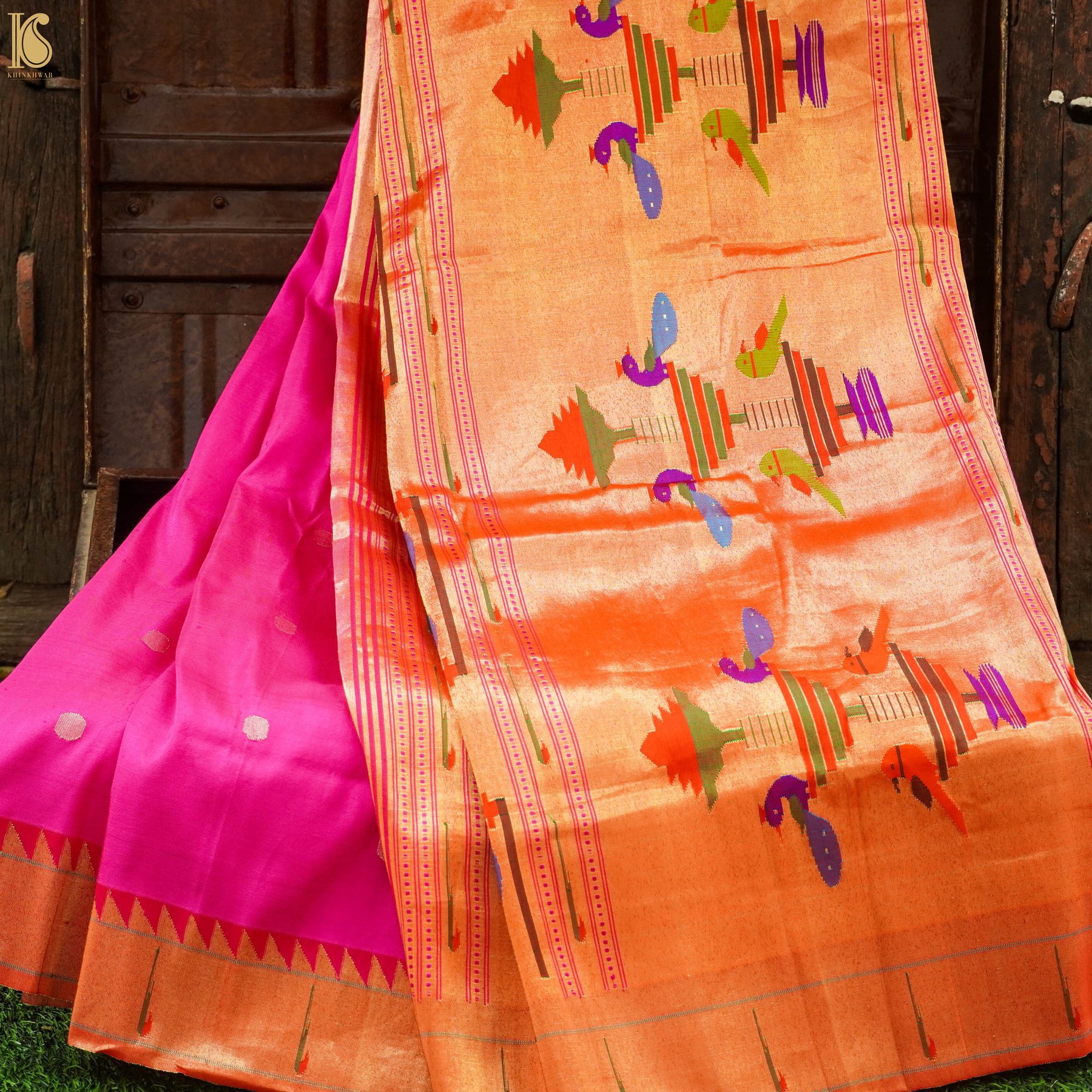
Source- https://khinkhwab.com/products/pink-pure-silk-handwoven-paithani-saree-with-muniya-border
The art of weaving a Paithani silk saree is more than 2000 years old and the spectrum of this art has only broadened with time. The work of zari on the Paithani silk makes this saree a full-blown traditionally rich piece of cloth. The saree looks the same on both sides and the motifs woven with zari on the pallus are of peacocks, vines, birds, and flowers. The making of one Paithani saree takes days as it is purely woven using the same old and traditional technique by the artisans. Paithani saree is like a heartthrob for the women of Maharashtra and you will see at least one Paithani silk in the closet of all the traditional Marathi families.
The tapestry technique is used for making the patterns with zari on the Paithani silk using the weft threads. Intricate and delicate patterns are made using the multicolored threads on a pure golden background to bring out the hues as vividly as possible. The art of making a beautiful Paithani silk saree is like a legacy that is being continued in its best form!
Thus, exploring all the fabrics and textiles of India is a whole journey and we have just begun with it! We will get back on the caravan and continue with the process of unraveling all the gorgeous fabrics along with their craftsmanship and techniques with you. Till then, enjoy exploring and raving about the ones here:)
Write, Record and Answer! Consume Unlimited Content! All you need to do is sign in and its absolutely free!
Continue with one click!!By signing up, you agree to our Terms and Conditions and Privacy Policy.










